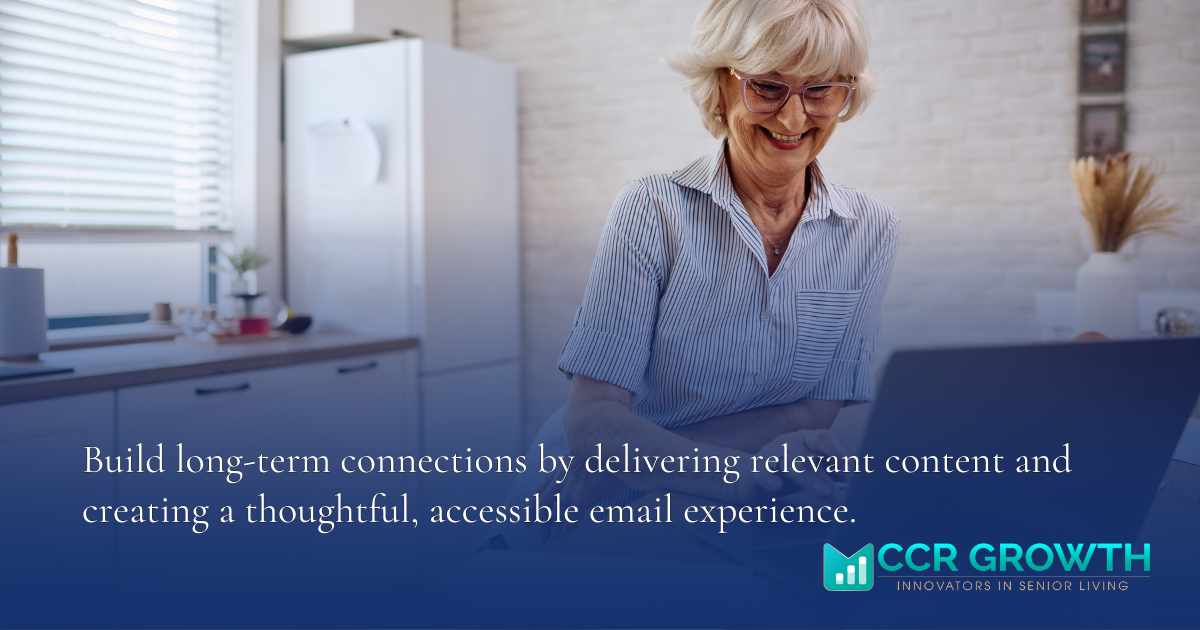
CCR Growth
A Step-by-Step Guide on Email Marketing to Seniors
Senior living communities face the challenge of connecting with older adults and their families in a way that resonates and drives action. Email marketing to seniors offers a powerful, cost-effective way to engage this audience, provided it’s done with precision and care.
This guide outlines a clear, step-by-step process for creating effective email campaigns tailored to the senior audience, ensuring consistent communication and measurable results for your community.

Outline
Published on
8/6/2025
Key Takeaways
- Successful email marketing to seniors starts with understanding your audience—both older adults and the family members involved in their decisions.
- A segmented, high-quality email list built from meaningful interactions improves personalization and engagement.
- Accessible design, clear subject lines, and mobile-friendly formatting are essential for reaching this age group effectively.
- Email marketing automation enables consistent communication, timely follow-ups, and smarter performance tracking.
- Coordinating your email campaigns with direct mail, print materials, and other marketing channels strengthens your message and drives results.
Step 1: Define Your Senior Audience and Goals
Start by analyzing the senior audience to inform your marketing strategy. Older adults, particularly baby boomers, value clear, trustworthy communication that addresses their specific interests, such as health, independence, or community engagement. Family members, especially adult children, often influence the decision-making process, so your emails must appeal to both seniors and their families. Segment your audience based on needs—some may seek detailed information about Alzheimer’s disease care, while others prioritize active living options.
Set specific goals for your email campaigns. Are you aiming to generate initial inquiries, nurture relationships with potential residents, or encourage move-ins? A data-driven approach ensures your emails deliver relevant content, increasing click-through rates and engagement. This step lays the foundation for targeting seniors effectively and aligning your efforts with your community’s business objectives.
Step 2: Build a High-Quality Email List
A successful email marketing campaign relies on a clean, targeted email list. Collect email addresses through website forms, community events, or referrals from your sales team. Ensure compliance with privacy regulations like CAN-SPAM to build trust with your audience. Personalization efforts are critical. Use data to segment your list based on recipients’ interests or their stage in the decision-making process, such as whether they’re exploring memory care or independent living.
For example, a potential resident inquiring about social activities might receive emails highlighting community events, while a family member could get content about safety features. A well-organized list ensures your email communications remain relevant, increasing the likelihood of engagement from seniors and their families.
Step 3: Design Accessible Email Templates
Seniors access emails on mobile devices or desktops, making responsive design essential. Create a clean layout with large, readable fonts and minimal clutter to ensure accessibility for older adults. Avoid excessive images, which can slow down loading on older devices and create issues with certain email programs. Instead, use warm, visually appealing visuals that reflect your community’s compassionate environment, adding a personal touch without overwhelming the reader.
Write compelling subject lines to capture attention. For instance, “Discover Our Community’s Support for Your Loved One” speaks to family members, while “Exclusive Discounts on Senior Living” targets potential residents. Ensure the email content delivers on the subject line’s promise, providing useful information that feels valuable and relevant to the senior audience.
Step 4: Create Compelling and Educational Content
The core of email marketing to seniors is delivering content that informs and engages. Educational content, such as guides on navigating senior living options or tips for maintaining independence, positions your community as a trusted resource. Avoid overly promotional language; instead, focus on addressing the audience’s concerns. For example, an email for older adults with mobility needs could detail accessibility features, while another might highlight activities tailored to baby boomers.
Incorporate interactive content, such as links to virtual tours or polls about preferred amenities, to boost engagement. Include clear calls to action, like “Schedule a Tour Today” or “Learn About Our Memory Care Services,” to guide recipients toward the next step. Each email should offer value, whether through practical advice, success stories, or exclusive discounts, ensuring it resonates with your target audience.
Step 5: Implement Email Marketing Automation
Marketing automation streamlines your email campaigns, saving time and ensuring consistent communication. Use email marketing automation platforms to schedule emails, segment audiences, and track performance. For instance, set up a drip campaign to nurture relationships with potential residents who’ve made an initial inquiry. The first email might introduce your community, the second could share a resident success story, and the third might offer an event invitation.
Automation also enables behavior-based follow-ups. If a recipient clicks a link about Alzheimer’s care, send a follow-up with detailed information on memory care services. Monitor metrics like open rates and click-through rates to refine your approach, ensuring your campaigns remain effective and relevant to seniors and their families.
Step 6: Integrate with Other Marketing Channels
Email marketing thrives when coordinated with other marketing channels. Pair email campaigns with direct mail and print materials to reinforce your message. A potential resident who receives a personalized postcard followed by a tailored email is more likely to engage. Your website should complement your emails with a clean layout, easy navigation, and consistent calls to action that mirror your email content.
Share email content, such as success stories or educational tips, on social media platforms where family members and younger groups are active. This integrated approach creates multiple touchpoints, ensuring your message reaches both seniors and their adult children, strengthening your brand and building trust with potential clients.
Step 7: Track and Optimize Campaign Performance
Continuous evaluation is critical for successful email marketing. Track metrics like open rates, click-through rates, and conversions to assess performance. If an email offering exclusive discounts has a low click-through rate, test a new subject line or adjust the content to better align with your audience’s interests. A/B testing elements like calls to action can reveal what resonates with older adults.
Regularly update your email list to remove inactive subscribers, maintaining deliverability. Collaborate with your sales team to understand how email interactions translate into move-ins. This feedback ensures your campaigns align with your community’s business goals, driving measurable results.
Step 8: Address Challenges and Build Long-Term Connections
Marketing to seniors presents unique opportunities and challenges. Older audiences may be less tech-savvy, requiring simple navigation and clear instructions. In some cases, family members manage or access email accounts on behalf of older adults. Therefore, your content should speak to both the senior and the family member involved in the decision-making process.
To stand out in a crowded inbox, offer unmatched value through personalized offers, heartfelt storytelling, or practical advice. Consistent, thoughtful email communications keep your community top of mind, guiding potential residents from initial inquiry to move-in. Delivering relevant content creates lasting connections that drive long-term success.
Strategic Email Marketing That Drives Real Outcomes
Email marketing to seniors continues to be one of the most powerful tools available for senior living communities. It provides a direct, measurable, and highly customizable way to communicate with older adults, their families, and decision-makers. When email campaigns are guided by clear goals, structured automation, accessible design, and targeted educational content, they drive meaningful engagement that moves beyond the inbox.
For many older adults, email remains a preferred form of digital communication. It integrates seamlessly into their daily lives and allows them to engage with your message at their own pace. As communities in the senior care industry explore more advanced practices, a strong email marketing strategy isn’t optional; it’s essential.
If your community is ready to elevate its email marketing performance with a data-driven approach that converts interest into move-ins, CCR Growth can help. Our team works closely with senior living operators to design marketing systems that actually make sense for your target age group.
Ready to Build Better Email Campaigns?
Reach out to CCR Growth to see how our experts can transform your email communications into a consistent, high-converting marketing channel. We don’t just optimize campaigns—we align marketing, sales, and business systems to ensure long-term success.
Contact us today to schedule a discovery session and see how our proven methods deliver better results, faster.
Frequently Asked Questions
1. What type of content performs best when marketing to senior citizens via email?
Email content that is direct, informative, and easy to digest performs best for this age group. Many seniors prefer messages that avoid flashy design and instead focus on providing useful information, practical guidance, and details about community life.2. Is it effective to use bullet points in emails to older adults?
While bullet points can help structure information, they should be used sparingly. Older audiences often prefer full sentences and clearly written paragraphs. Excessive formatting, especially in small text or cluttered layouts, can disrupt readability. A clean layout with consistent spacing and hierarchy remains the better approach.3. How can digital communication be personalized for both seniors and their family members?
Personalization must strike a balance. Reference the recipient’s name, include specific interests, and use email triggers that align with their stage in the decision-making process. For adult children, highlight caregiving support or financial options. For potential residents, focus on lifestyle, amenities, and independence. Segmentation ensures the content speaks directly to the reader, even if the email is shared.4. What are best practices for communities building long-term email marketing strategies for older audiences?
Start with a clean list, ensure every email has a clear purpose, and maintain consistent communication without becoming intrusive. Focus on relevant content, avoid technical jargon, and regularly review campaign data to adjust your approach. For communities serving seniors, long-term success comes from providing ongoing value and staying aligned with the needs of your potential residents.Subscribe to our newsletter
Sharpen your expertise and stay ahead of senior living industry trends—subscribe to CCR Growth’s newsletter for exclusive insights and updates.
Recent Posts



A Complete Guide to Generative Engine Optimization for Senior Living
Redefining Senior Living Marketing, Sales, and Operations
CONTACT ADDRESS
8710 Carmel Valley Road, Carmel, CA 93923
GENERAL INQUIRIES
info@ccrgrowth.com
(831) 273-3628
SOCIAL MEDIA





